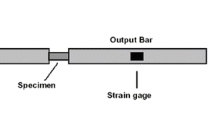Abstract
A bimetallic strip consists of two different metal pieces that are bonded together. Due to the different coefficients of thermal expansion, exposing the strip to temperature induces thermal stresses that cause the structure to bend. Most often, incremental finite-element methods that introduce element nodal coordinates have been successfully applied to analyze the thermally induced vibrations in such systems. The exposure of these bimetallic strips to high temperatures results in large deflections and deformations, where the effects of the rigid-body motion and large rotations must be taken into account. For classic, non-isoparametric elements such as beams and plates the incremental methods do not result in zero strains under arbitrary, rigid-body motion. Therefore, in this paper a new model of a bimetallic strip is proposed based on a coupled thermo-structural analysis using the absolute nodal coordinate formulation. The applied, non-incremental, absolute nodal coordinate formulation uses a set of global displacements and slopes so that the beam and the plate elements can be treated as isoparametric elements. In order to simulate the bimetallic strip’s dynamic response, the formulation of the shear-deformable beam element had to be extended with thermally induced stresses. This made it possible to model the coupled thermo-structural problem and to represent the connectivity constraints at the interface between the two strips of metal. The proposed formulation was verified by comparing the responses using a general-purpose finite-element software.








Similar content being viewed by others
References
Sedighi, M., Dardashti, B.N.: A review of thermal and mechanical analysis in single and bi-layer plate. Mater. Phys. Mech. 14(1), 37–46 (2012)
Boisseau, S., Despesse, G., Monfray, S., Puscasu, O., Skotnicki, T.: A bimetal and electret-based converter for thermal energy harvesting. ArXiv e-prints, pp. 1–3 (2012)
Muzychka, Y.S., Yovanovich, M.M.: Analytic models to compute transient thermal stresses in bimaterial systems. In: Advanced Technology for Electronic Packaging, Austin, TX (1996)
Chu, W.-H., Mehregany, M., Mullen, R.L.: Analysis of tip deflection and force of a bimetallic cantilever microactuator. J. Micromech. Microeng. 3(1), 4–7 (1993)
Ross, D.S., Cabal, A., Trauernicht, D., Lebens, J.: Temperature-dependent vibrations of bilayer microbeams. Sens. Actuators A, Phys. 119(2), 537–543 (2005)
Suocheng, W., Yongping, H., Shuangjie, L.: The design and analysis of a MEMS electrothermal actuator. J. Semicond. 36(4), 1–5 (2015)
Zou, Q., Sridhar, U., Lin, R.: A study on micromachined bimetallic actuation. Sens. Actuators A, Phys. 78(2), 212–219 (1999)
Timoshenko, S.: Analysis of bimetal thermostats. J. Opt. Soc. Am. 11, 233–255 (1925)
Mirman, B.A.: Interlaminar stresses in layered beams. J. Electron. Packag. 114, 389–396 (1992)
Suhir, E.: Interfacial stresses in bimetal thermostats. J. Appl. Mech. 56, 595–600 (1989)
Suhir, E.: Thermally induced interfacial stresses in elongated bimaterial plates. Appl. Mech. Rev. 42, 252–262 (1989)
Hsu, T.-R.: MEMS and Microsystems: Design, Manufacture, and Nanoscale Engineering, 2nd edn. Wiley, New Jersey (2008)
Shabana, A.A.: Dynamics of Multibody Systems, 3rd edn. Cambridge University Press, Cambridge (2005)
Shabana, A.A.: Computer implementation of the absolute nodal coordinate formulation for flexible multibody dynamics. Nonlinear Dyn. 16(3), 293–306 (1998)
Escalona, J.L., Hussien, H.A., Shabana, A.A.: Application of the absolute nodal co-ordinate formulation to multibody system dynamics. J. Sound Vib. 214, 833–851 (1998)
Čepon, G., Boltežar, M.: Dynamics of a belt-drive system using a linear complementarity problem for the belt–pulley contact description. J. Sound Vib. 319(3), 1019–1035 (2009)
Mikkola, A.M., Shabana, A.A.: A new plate element based on the absolute nodal coordinate formulation. In: ASME Design Engineering Technical Conferences and Computers and Information in Engineering Conference, Pittsburgh, PA, September, pp. 9–12 (2001)
Dufva, K.E., Sopanen, J.T., Mikkola, A.M.: A two-dimensional shear deformable beam element based on the absolute nodal coordinate formulation. J. Sound Vib. 280, 719–738 (2005)
Omar, M.A., Shabana, A.A.: A two-dimensional shear deformable beam for large rotation and deformation problems. J. Sound Vib. 243(3), 565–576 (2001)
Vallejo, D.G., Mikkola, A.M., Escalona, J.L.: A new locking-free shear deformable finite element based on absolute nodal coordinates. Nonlinear Dyn. 50, 249–264 (2007)
Gerstmayr, J., Shabana, A.A.: Analysis of thin beams and cables using the absolute nodal co-ordinate formulation. Nonlinear Dyn. 45, 109–130 (2006)
Sopanen, J.T., Mikkola, A.M.: Description of elastic forces in absolute nodal coordinate formulation. Nonlinear Dyn. 34, 53–74 (2003)
Matikainen, M.K., Dmitrochenko, O., Mikkola, A.M.: Beam elements with trapezoidal cross section deformation modes based on absolute nodal coordinate formulation. In: Proceedings of the International Conference of Numerical Analysis and Applied Mathematics, Rhodes, Greece (2010)
Gerstmayr, J., Irschik, H.: On the correct representation of bending and axial deformation in the absolute nodal coordinate formulation with an elastic line approach. J. Sound Vib. 318, 461–487 (2008)
Dufva, K.E., Sopanen, J.T., Mikkola, A.M.: A two-dimensional shear deformable beam element based on the absolute nodal coordinate formulation. J. Sound Vib. 280, 719–738 (2005)
Vallejo, D.G., Valverde, J., Dominguez, J.: An internal damping model for the absolute nodal coordinate formulation. Nonlinear Dyn. 42, 347–369 (2005)
Abbas, L.K., Rui, X., Marzocca, P.: Aerothermoelastic analysis of panel flutter based on the absolute nodal coordinate formulation. Multibody Syst. Dyn. 33(2), 163–178 (2015)
Shen, Z., Tian, Q., Liu, X., Hu, G.: Thermally induced vibrations of flexible beams using absolute nodal coordinate formulation. Aerosp. Sci. Technol. 29(1), 386–393 (2013)
Shabana, A.A., Yakoub, R.Y.: Three dimensional absolute nodal coordinate formulation for beam elements: theory. J. Mech. Des. 123(3), 606–613 (2001)
Author information
Authors and Affiliations
Corresponding author
Rights and permissions
About this article
Cite this article
Čepon, G., Starc, B., Zupančič, B. et al. Coupled thermo-structural analysis of a bimetallic strip using the absolute nodal coordinate formulation. Multibody Syst Dyn 41, 391–402 (2017). https://doi.org/10.1007/s11044-017-9574-7
Received:
Accepted:
Published:
Issue Date:
DOI: https://doi.org/10.1007/s11044-017-9574-7




